I land at the airport in Bozeman Montana. There is much snow on the ground, high up on buildings, covering parked cars. Visibility is poor due to very foggy conditions. I am told that last week, the weather was sunny and balmy (relatively speaking) until the day before I arrive when a huge storm brought lots of snow and frigid temperatures. And for the fourth time in two years, I am in an environment that makes me numb.
I haven’t been in Yellowstone, America’s first national park (dedicated March 1, 1872), since 1976 on a cross-country drive. Now nearly forty five years later, I figure I am long overdue for another visit. In three hours, I am transported by shuttle to the northeastern area of the park where I spend the next three days learning about wolves and biodiversity through the Yellowstone Institute’s Wolf Discovery program. I am here with a group of twelve and a naturalist guide.
On our first day in the park, we are on the road at 6:30 am. It is freezing. I am wearing everything I’ve brought with me and still it’s not enough. We don’t see any wolves but we do see great herds of bison; bull elk crowned with huge antlers, sometimes weighing more than twenty pounds; coyotes (easily mistaken for wolves by certain city slickers), a beautiful red fox with a long bushy tail; and a very large otter eating the fish that it has caught in the icy river. We go snowshoeing in the afternoon when the sun finally appears making the landscape even lovelier, but sadly still doesn’t warm my toes.
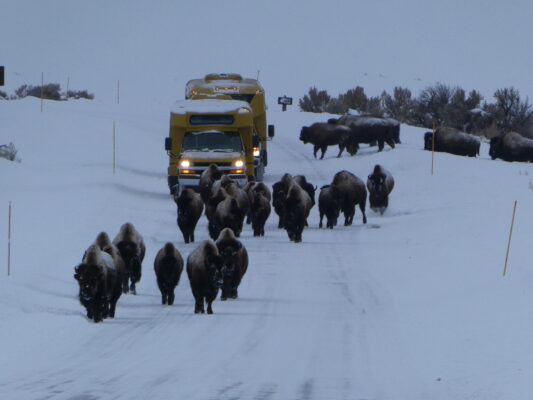
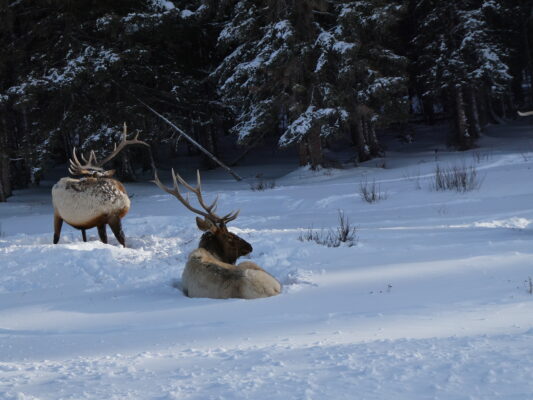
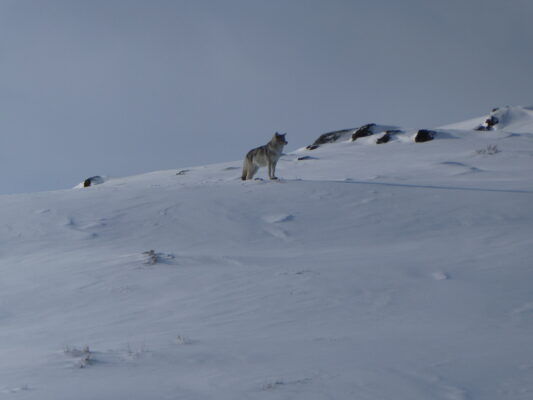
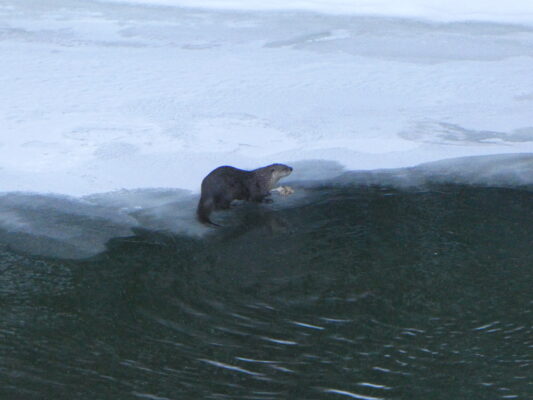
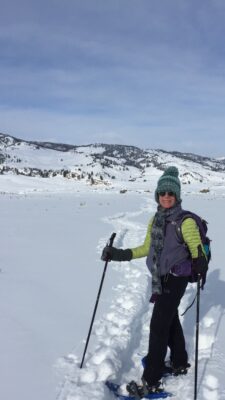
I learn that 96% of the park is in Wyoming, 3% in Montana, and 1% in Idaho. Nevertheless, Montana claims it as its own! The park is twenty million acres in size and currently home to stable populations of wolves, elk, bison, mountain lions, bighorn sheep, mountain goats, coyote, red fox, moose, bear, eagles, beaver, among others. Yellowstone is a scientific research laboratory. We’re told three hundred fifty seven research permits have been issued in the last year for all sorts of projects.
Wolves were removed from Yellowstone by 1926 because then current science said eliminating these predators would be good for the elk, deer and bison populations. This turned out not to be the case when the entire ecosystem was disrupted. As a result, wolves were reintroduced from Canada in 1995 and again in 1996, a total of 31, with great success. The wolf population now numbers 101.
When we depart at 6:30 on the second day, it is 19 degrees below zero. The sky is crystal clear. The sun has not yet risen. Wolves had been seen late the previous afternoon (unfortunately, not by us). So we return to the area where they had been seen and spend the next four hours (!) looking for them. Using a long distance scope, the guide shows us a wolf lying down in the snow two miles away. In my opinion, this doesn’t count. We decide not to snowshoe because it is too cold and continue to look for wildlife instead. We are rewarded with moose and bighorn sheep. Before calling it a day, we return to the “wolf sighting spot” to check again for wolves and learn that just fifteen minutes before, fourteen of the pack had walked by. As proof, we are shown a video taken by the lucky observer.
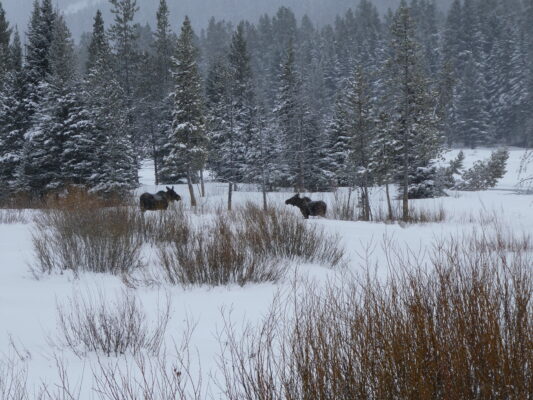
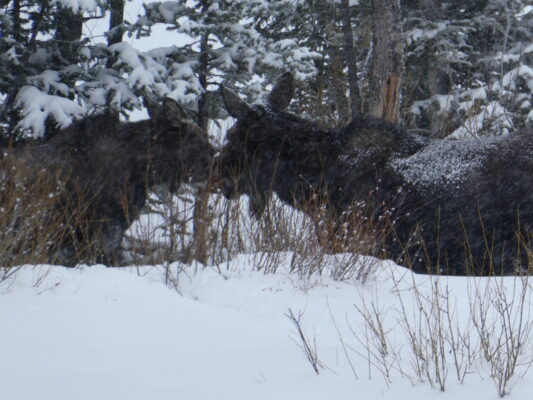
Day three, same routine, same viewing spot. And the wolves are there! Well, they’re still two miles away. But, I can see them through the scope, eight or more, moving around. It’s snowing pretty hard though and visibility gets so bad that they can’t be seen anymore. The last afternoon, we go snowshoeing under falling snow in the silent, still majesty of midwinter in Yellowstone.
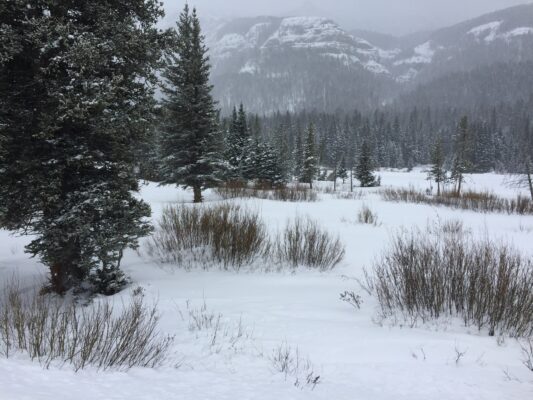
How lucky I am to be able to experience Yellowstone, its splendid scenery, and abundant wildlife in a variety of weather-grey skies, brilliant sunshine, and falling snow- and to learn about the complex ecosystem and the many flora and fauna that make it work.
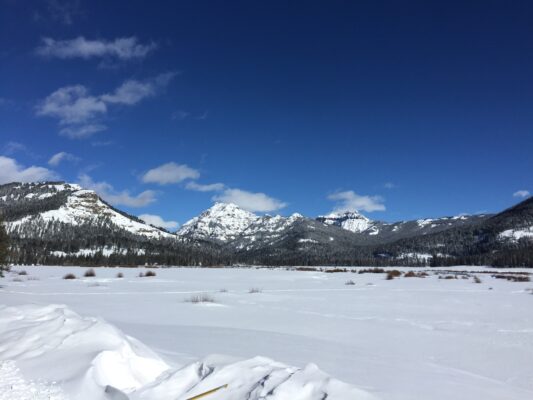
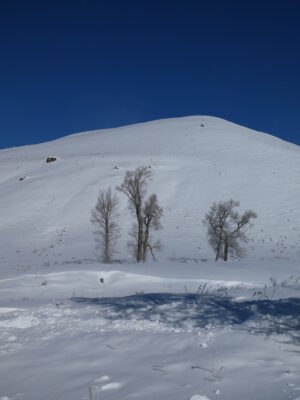
And cold. Ever cold. I think I’m finally done with cold climate destinations. But I know I’ve said that before. I guess we’ll just see.

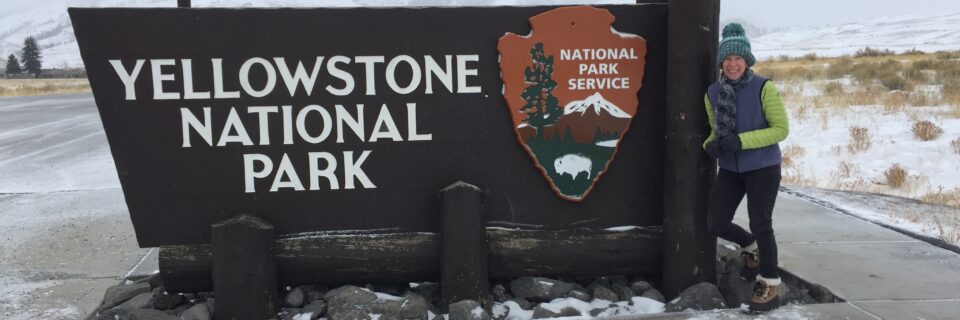
5 Comments
Well told tale of your Yellowstone experience. Loved all the pictures. Can not believe you were in 19 below temperature. And I seriously doubt that is the last time you will travel to a cold environment.
Loved your postcard! Coincidentally, we are in Evergreen, Colorado (where we lived 42 years ago) and heading to Jackson Hole tomorrow. From there we are heading to West Yellowstone and then into the park for 3 days. Too bad we missed each other! Ron was there in 1976, the first year it was open in the winter. Sure hope it has warmed up :-). Thanks again for the postcard!
Adele, thanks for bringing us along! This brought back wonderful memories for me, of my 2 cross-country ski trips to Yellowstone. Great photos!
Yellowstone is my favorite national park. I want to go back. Maybe one more time in the spring and once in the winter to cross country ski. Thanks for sharing.
Yay, more moose in the wild!